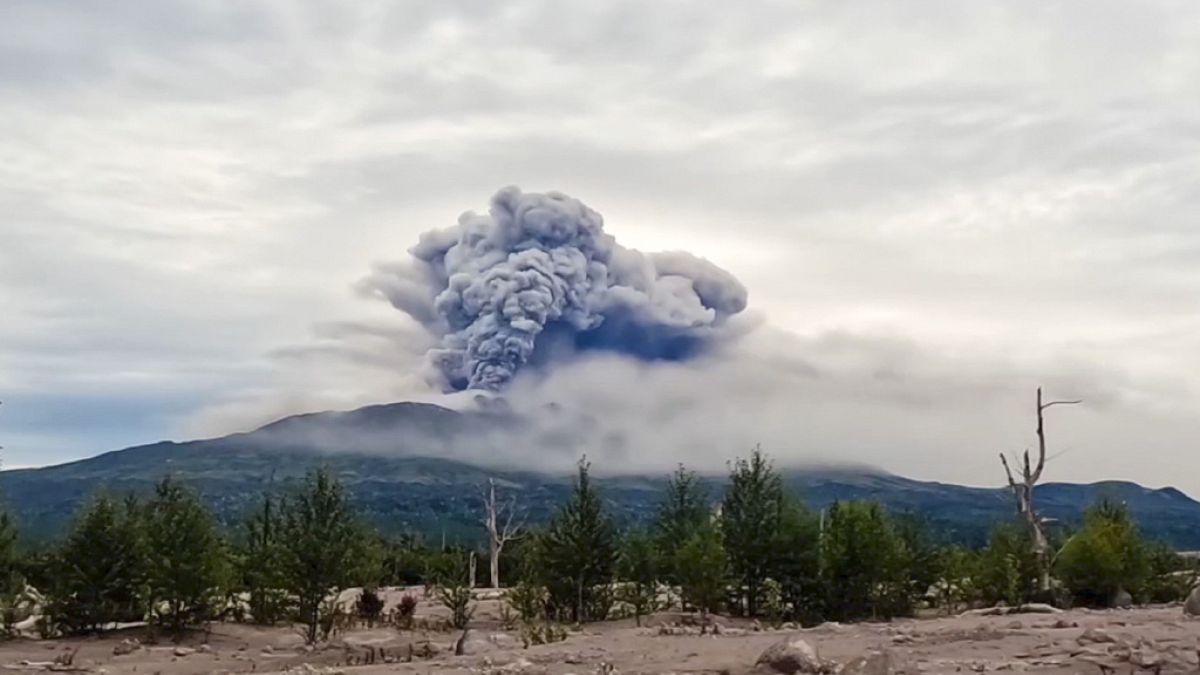On Sunday, the Shiveluch volcano in Russia erupted, sending ash clouds 5 kilometers into the sky over the Kamchatka Peninsula. This eruption was triggered shortly after a powerful 7.0-magnitude earthquake struck off the coast of Kamchatka, according to volcanologists. The Russian Academy of Sciences Institute of Volcanology and Seismology released a video showing the ash cloud that extended over 490 kilometers east and southeast of the volcano. Additionally, the Ebeko volcano on the Kuril Islands also erupted, spewing ash 2.5 kilometers high. The earthquakes in the region may be a precursor to a stronger quake in southeastern Kamchatka, with scientists warning of a potential magnitude 9.0 earthquake within 24 hours.
Following the eruption of the Shiveluch volcano, a “code red” ash cloud warning was issued, briefly putting aircraft in the area on alert. The Kamchatka Volcanic Eruption Response Team reported on the warning, stating that commercial flights were not disrupted, and there was no damage to aviation infrastructure. The earthquake that triggered the eruptions occurred at a depth of 6 kilometers under the sea bed, with the epicenter located 108 kilometers southeast of the nearest city. While there were no immediate reports of injuries from the earthquake, residents of Petropavlovsk-Kamchatsky, a port city with over 181,000 people, reported feeling some of the strongest shaking in a long time.
Russian emergency officials have raised concerns about the possibility of a second, more powerful earthquake striking southeastern Kamchatka. The Institute of Volcanology warned that a potential second quake could occur within 24 hours, with a magnitude approaching 9.0. This raises fears of more seismic activity in the region, which could have significant consequences. The last major earthquake in Kamchatka occurred on November 4, 1952, with a magnitude of 9.0, causing damage but no reported deaths, despite generating 9.1-meter waves in Hawaii. The potential for a similar or stronger earthquake poses a serious threat to the safety and infrastructure of the region.
The eruptions of the Shiveluch and Ebeko volcanoes serve as a reminder of the volatile nature of the Ring of Fire, the region with a high amount of seismic and volcanic activity surrounding the Pacific Ocean. In Russia, where numerous active volcanoes are located, monitoring and research are crucial to understanding and predicting volcanic eruptions. The Russian Academy of Sciences and other institutions play a key role in studying these natural phenomena and providing warnings to protect the population and infrastructure from potential disasters. With the recent eruption and earthquake in Kamchatka, scientists are on high alert and monitoring the situation closely to assess the risk of further seismic activity.
Despite the potential dangers posed by the recent volcanic eruptions and earthquakes in Kamchatka, the immediate impact on the region appears to be limited. While the ash clouds and seismic activity are cause for concern, there have been no reports of injuries or significant damage. The swift response of authorities in issuing warnings and monitoring the situation has helped mitigate the risks to the population and aviation sector. Continued monitoring and research into the seismic and volcanic activity in Kamchatka are essential to preparing for future events and ensuring the safety and well-being of the residents of the region. By understanding the geological processes at work and preparing accordingly, the threat of natural disasters can be minimized, and communities can be better equipped to respond effectively in times of crisis.
In conclusion, the recent eruption of the Shiveluch volcano in Russia, triggered by a powerful earthquake in Kamchatka, highlights the unpredictable and potentially dangerous nature of volcanic activity. The threat of a second, more powerful earthquake in the region adds to the concerns of scientists and authorities, who are closely monitoring the situation. While the immediate impact of the eruptions and earthquakes has been limited, the potential for further seismic activity raises the need for continued vigilance and preparedness. The importance of research, monitoring, and early warning systems in mitigating the risks posed by natural disasters cannot be overstated. As Russia grapples with these recent events, the focus remains on ensuring the safety and security of the population while working to better understand and predict future volcanic and seismic activity in the region.































